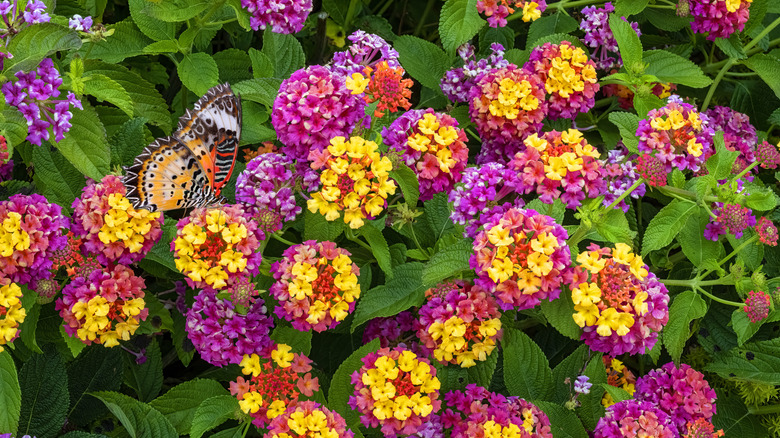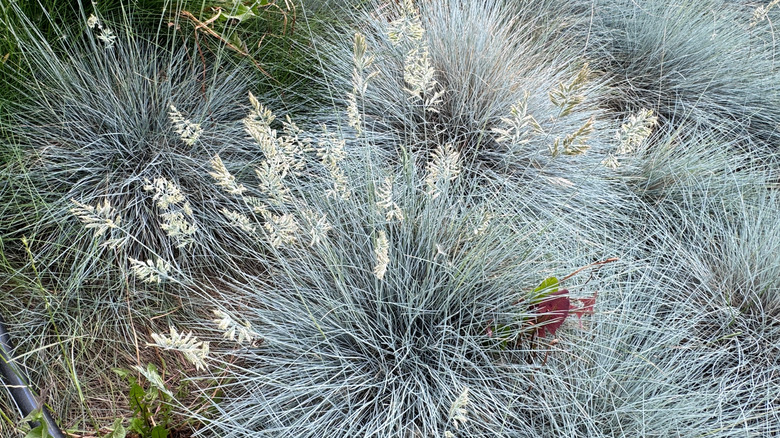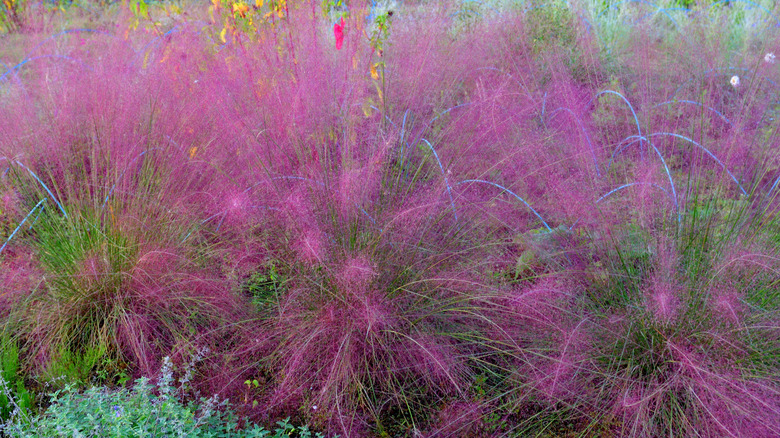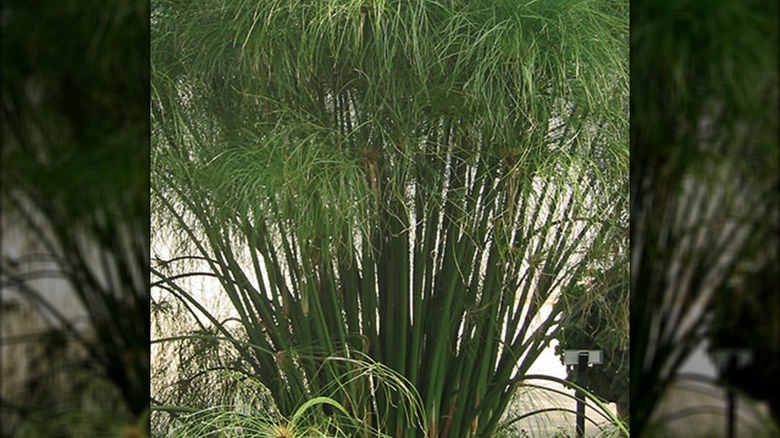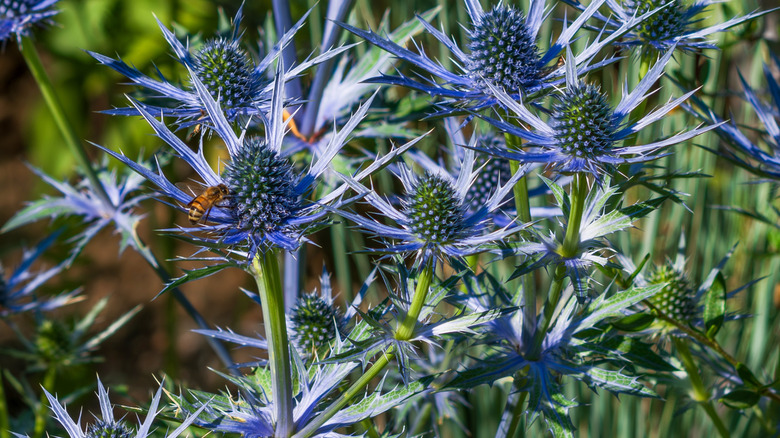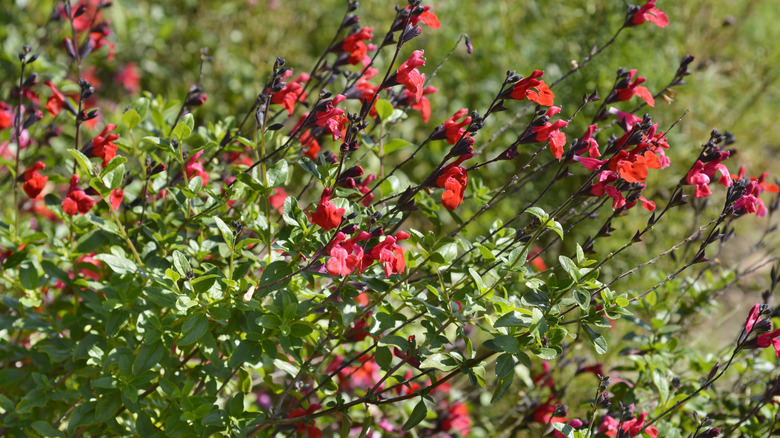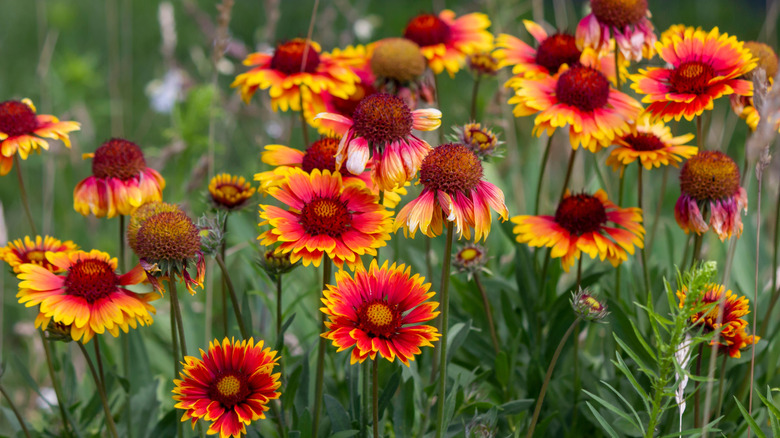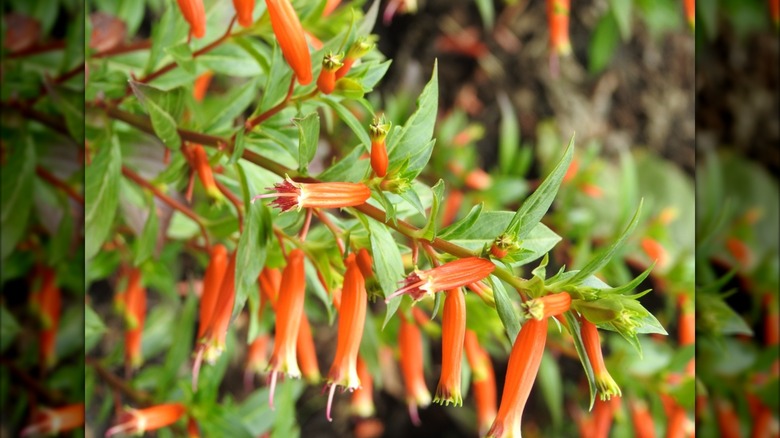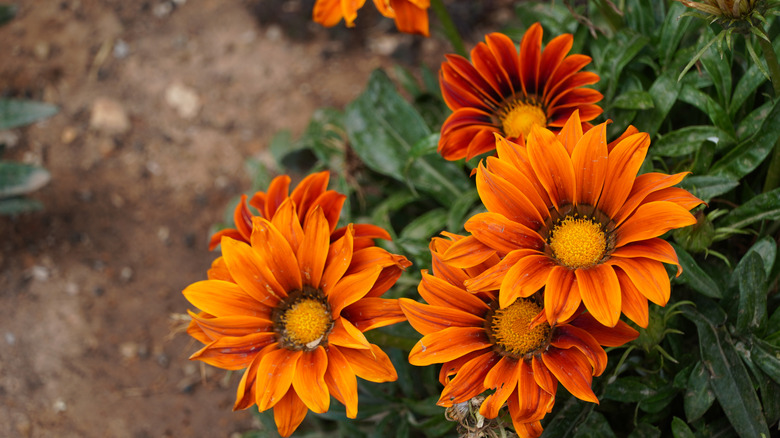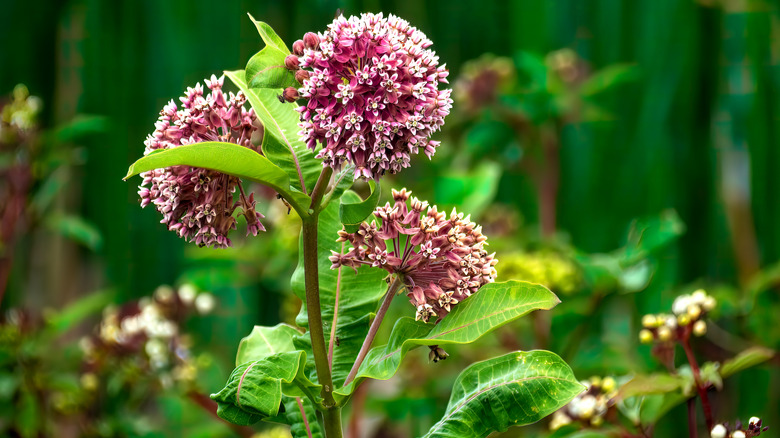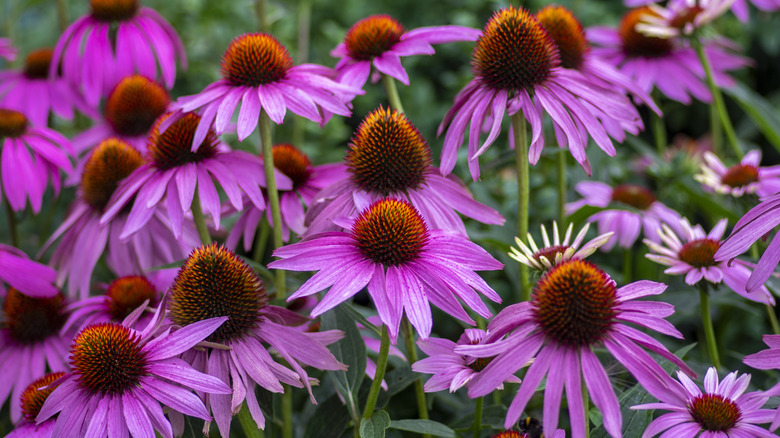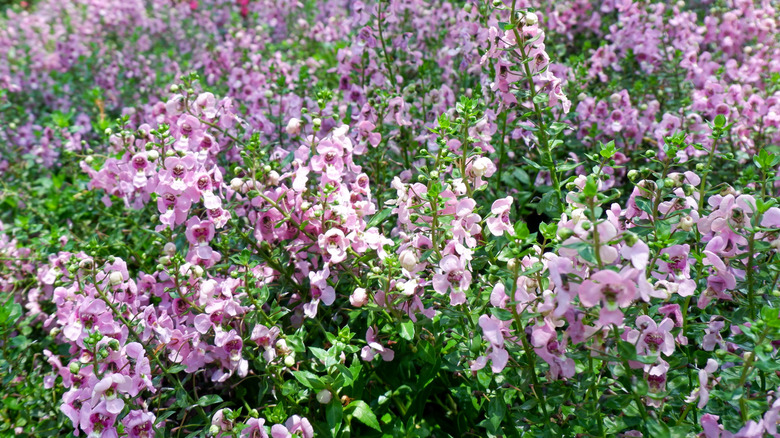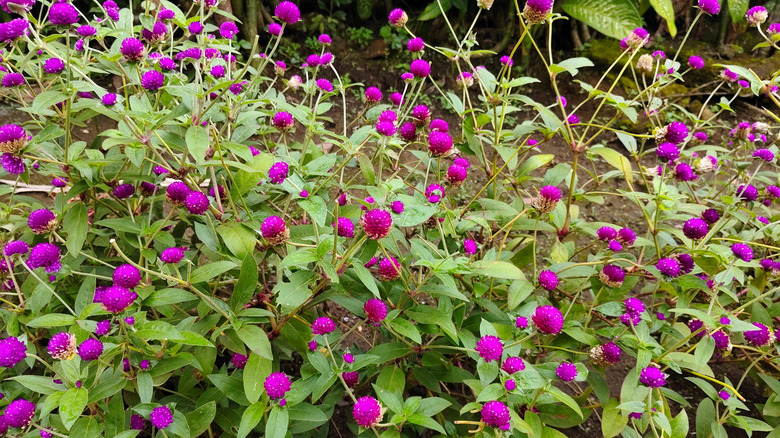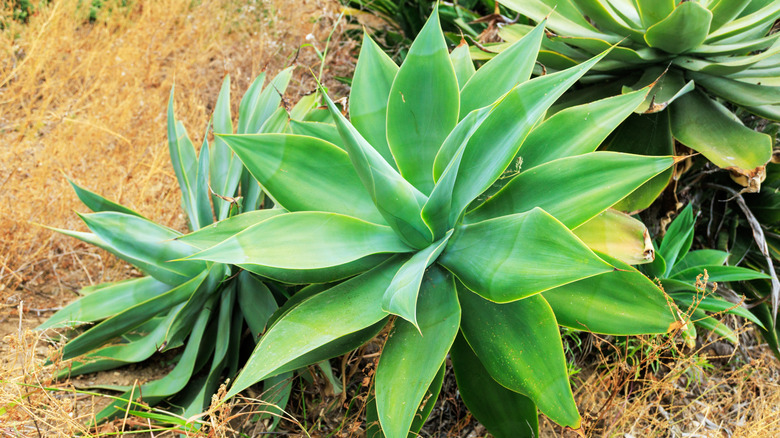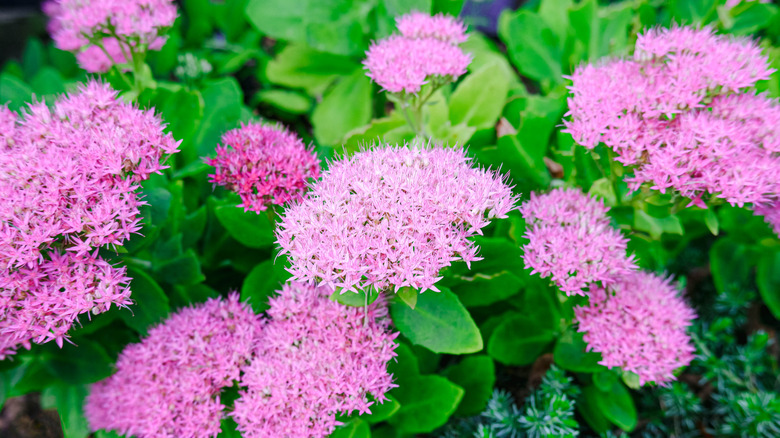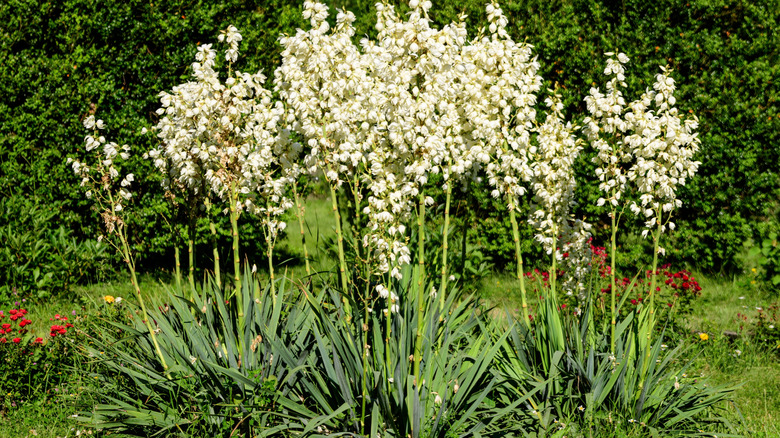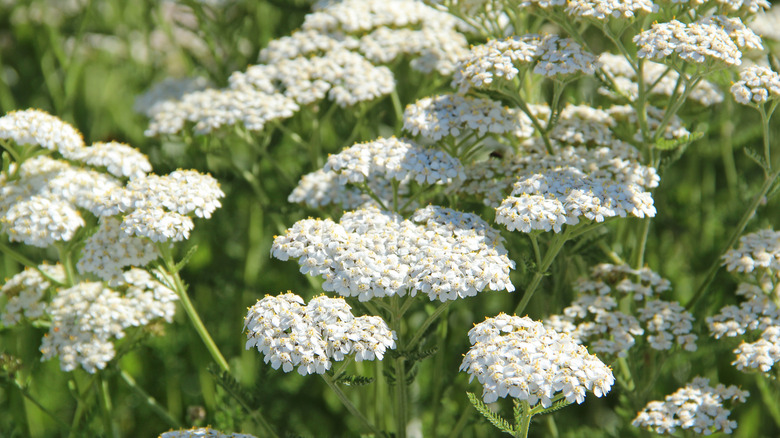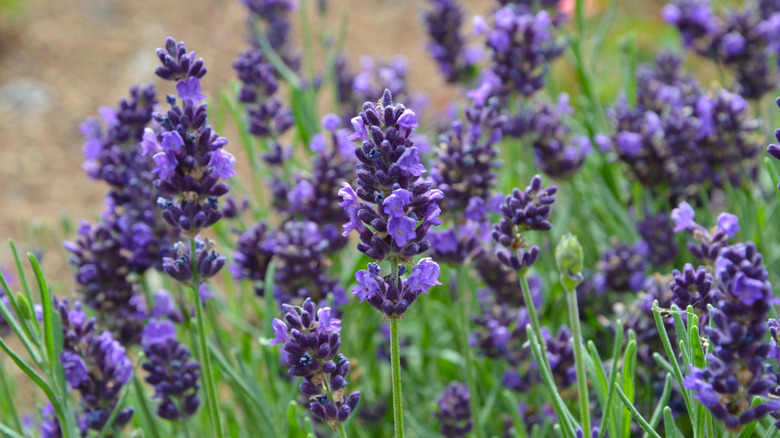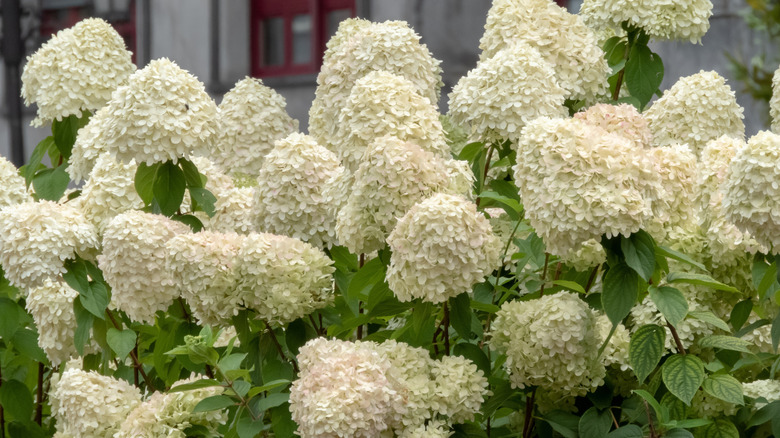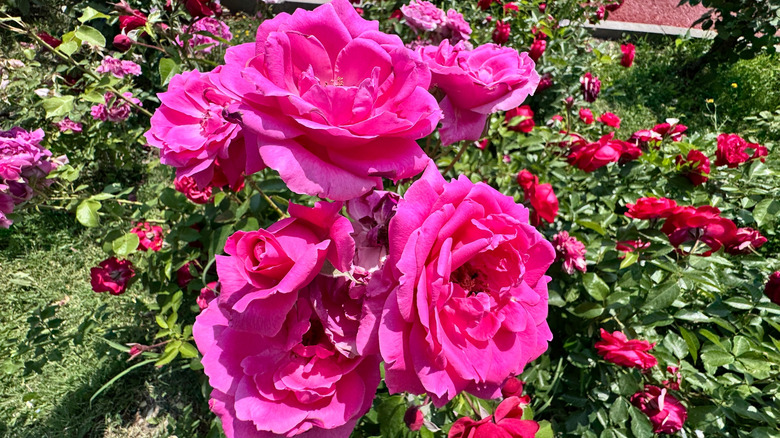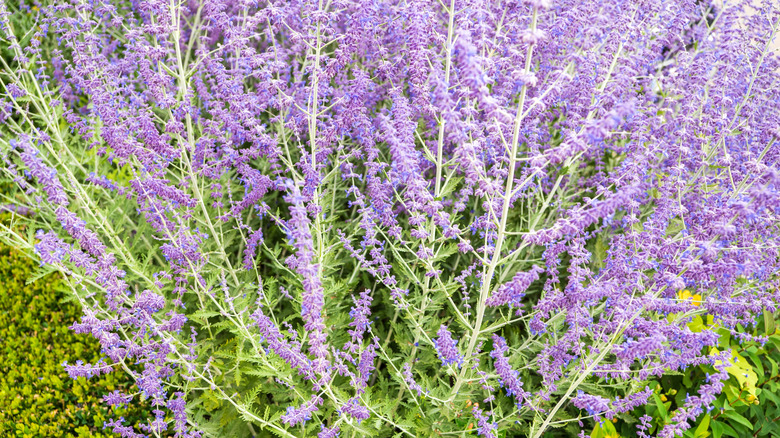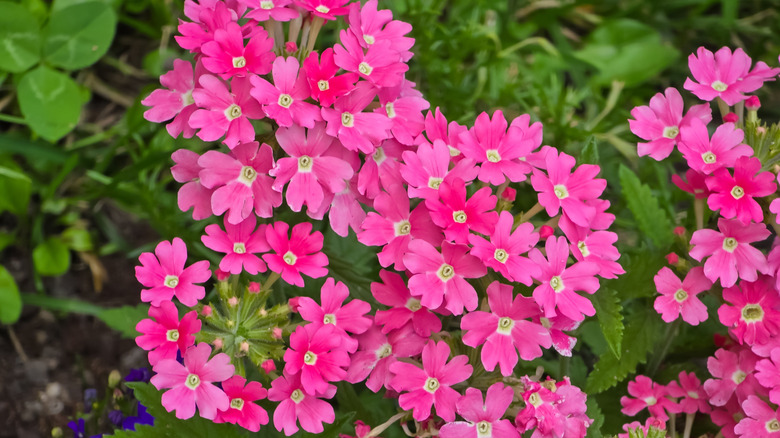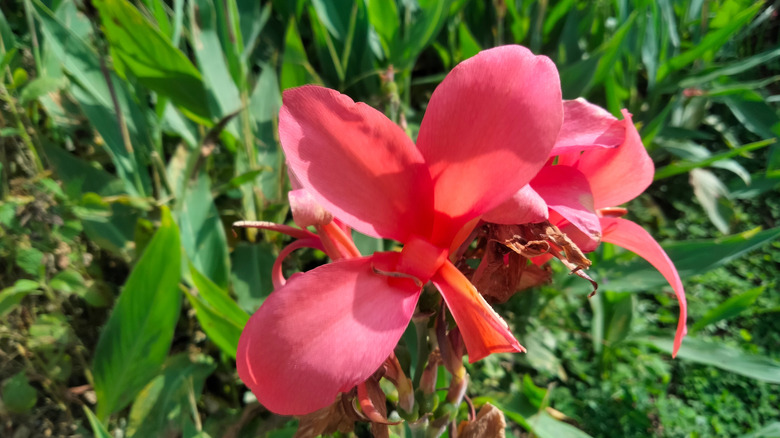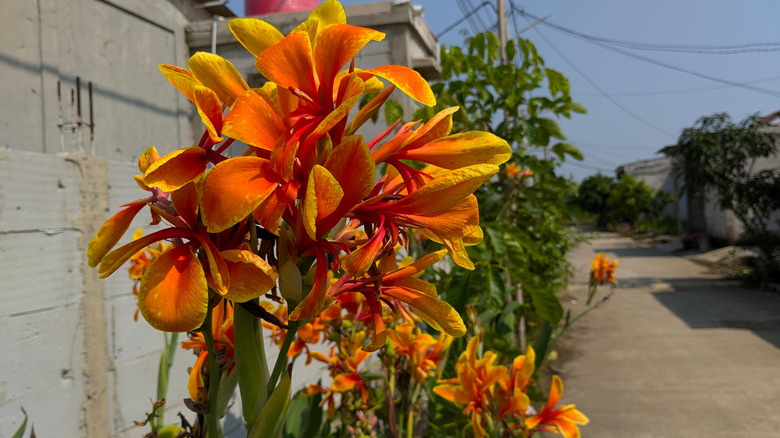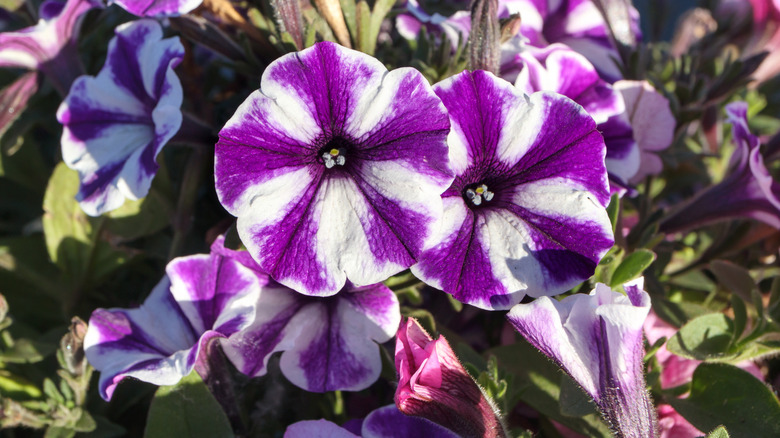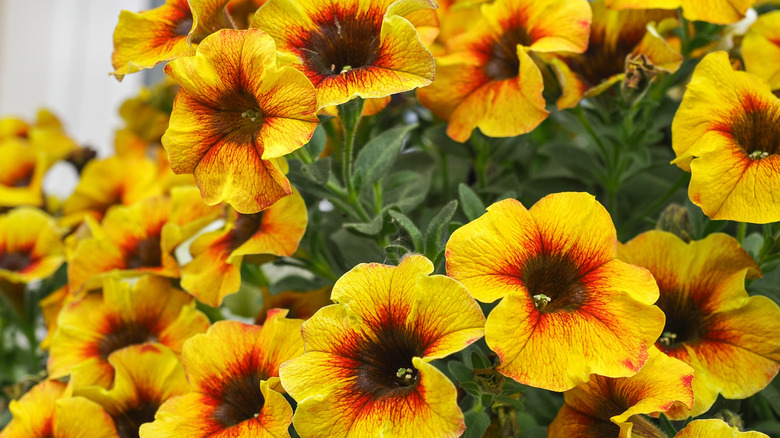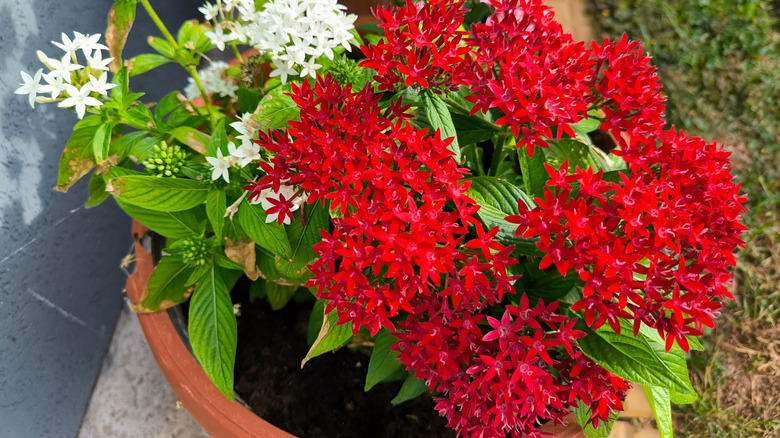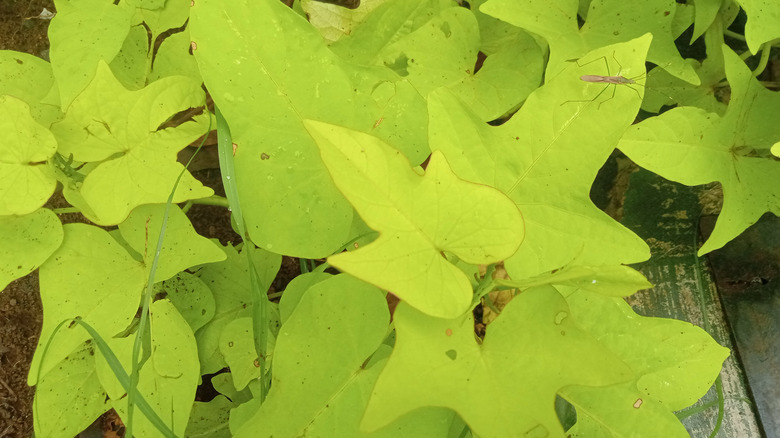The 27 Best Flowers To Plant Alongside Your Lantanas
Low-maintenance, pollinator-friendly, and a flowery display that lasts all spring until frost — these are all good reasons to grow lantanas in your yards and gardens. Yet, even the best flowers can eventually start to look stale and boring if you keep massing them in beds, even in different colors, year after year. Lantanas are no exception to this rule and greatly benefit when teamed with the right ornamentals.
So, how do you choose companions for lantanas? For starters, select plants to those requiring similar growth conditions, like full sun and well-draining soils. Next, you must take planting themes, functions, growth habits, and location into account. This means, if you're using lantana patches to attract pollinators, clubbing them with similarly friendly plants like milkweed, coneflowers, blanket flowers, and sage makes sense. But if you've popped them in dry sites, pair them with drought-tolerant plants, such as gazania or yarrow.
When trying to create textural contrasts, use architectural succulents like agave or ornamental grasses, such as pink muhly or blue fescue. If you're into keeping container gardens, sweet potato vines, petunias, and canna lilies function as gorgeous complements, especially if you're growing trailing varieties of lantanas. For those growing taller cultivars, you can pair them off with shrubs like panicle hydrangeas and roses. Now that we've touched upon the basics, here's a neat list of the 27 best flowers to plant next to lantanas.
Blue fescue
If you're using lantana to define borders, consider teaming it with blue fescue (Festuca glauca) for a visual and textural contrast. These cool-season grasses start off bluish-silver and grow greener as the season warms, finally turning spotty green in the fall. You may also use this pairing in water-wise landscapes, where this drought-tolerant ornamental grass will attract more feathered friends. Although cold hardy in zones 4 to 8, it remains evergreen only in the warmest climates, so expect the foliage to die back during winter if you live up north. You must separate the clumps every couple of years.
Pink muhly grass
In coastal gardens, couple lantana with pink muhly grass (Muhlenbergia capillaris), as they both exhibit a solid resistance to salt. Besides, the contrast is almost magical in late summer when this ornamental grass' pink plumes dance above a sea of green leaves and add a feathery texture to the space. Alternatively, you may use this combination in dry climates, as pink muhly grass can withstand heat and drought. Birds use them for seeds and cover, while butterflies covet their flowers, so mass planting them is an excellent option. These grasses grow well in zones 5 to 9.
Graceful Grasses 'King Tut' Egyptian papyrus
Graceful Grasses 'King Tut' Egyptian papyrus (Cyperus papyrus 'King Tut') is a fast-growing, evergreen grassy plant that's perennial in zones 10 and 11, but annual elsewhere where winter temperatures dip below 35 degrees Fahrenheit. Growing a pretty head of feathery leaves that can reach up to 6 feet high, this heat-tolerant plant can serve as a gorgeous foil for lantanas growing in moist or normal beds. Alternatively, you may pop it in containers as a filler plant, but don't try to overwinter it inside if you live in cold climates because it's unlikely to survive.
Sea holly
Sea holly (Eryngium planum) is another butterfly-friendly offering that you can grow with lantanas if you live near a beach, though it fares just as well inland. It's favored for its thistle-shaped flowerheads, usually in hues of purple, silver, or blue, that last all summer long. Unfortunately, their flowers, or more specifically, their pollen, smell far from pleasant, which explains why plenty of flies gather around them. So, avoid planting them en masse, and use them as specimens instead. Or, deadhead the flowers before you notice pollen production. Avoid growing them in rich soils to prevent legginess. Their hardiness zones run from 5 to 9.
Sage
Sun lovers, sage (Salvia spp.) is an excellent plant to grow alongside lantanas to attract more pollinators to your yard. Depending on the species (there are over 1000), expect hummingbirds to fly in enchanted with the red or pink blooms, while bees may drop in for their purple or blue flowers. Like lantanas, sage plants can bear drought stress and are useful to have where water is rationed during summers. If not in beds, give sage a home in borders where you can enjoy the minty fragrance emanating from its foliage. They are perennials in zones 5 through 10.
Blanket flower
Like lantanas, blanket flowers (Gaillardia spp.) produce waves of flowers, often in red, yellow, orange, or variegated colors, from spring through frost. Above all, they're also deer and rabbit-resistant, so planting the two flowers together can further pest-proof your borders and beds. Mass them to attract diverse pollinators, especially in xeric landscapes that may be prone to drought or salt runoff. However, note that blanket flowers, too, can irritate the skin, so you need to be mindful of where you plant this combination. Blanket flowers adapt well to the range running through zones 3 to 9.
Vermillionaire large firecracker plant
Tie in your lantana beds with the similarly-toned, red- and yellow-flushed, orange flowers on Vermillionaire large firecracker plant (Cuphea hybrid 'Cupver'). Perennials in zones 8 through 11, these heat-tolerant herbaceous plants bloom non-stop from planting until they're frost-killed. Plus, they don't require any deadheading. Better yet, hummingbirds love their flowers and are sure to fly in for the nectar. Brightly-lit, moist, and organically rich beds are where they thrive, though they can endure drought. Consider mulching their beds with pine needles in zone 8 to ensure successful overwintering. They're also strong contenders for planters.
Gazania
If you garden in dry, poor soils, gazania (Gazania spp.) is the daisy-like flower you'll want to attract butterflies. All summer long, the low-growing annual (perennial in zones 8b to 11) is covered in orange, yellow, or bi-color blooms that pair off beautifully with lantanas. Gazanias grow nearly 12 inches tall and can be used as groundcovers, especially on slopes where stopping soil erosion is important. They're fairly low maintenance, requiring less water overall, while offering excellent drought tolerance. Note, though, that without sun exposure, their blooms remain closed, such as on overcast days and at night. Keep deadheading for additional blooms.
Common milkweed
If you've eked out a small patch in your garden for butterflies and don't mind it growing a little wild, consider interplanting lantanas with common milkweed (Asclepias syriaca). Not only will the vast swathe of purple or pink flowers make the patch instantly pop in the summer, but it'll also attract many butterflies who find massed flower patches easier to locate. This should also help mask the extent of damage monarch caterpillars will cause to the plant's foliage and limit the requirement for constant deadheading to prevent volunteer seedlings. Common milkweed grows best in full sun sites in zones 3 to 9.
Coneflowers
In pollinator or drought-tolerant gardens, you can couple lantanas with coneflowers (Echinacea spp.), as they're popular with butterflies and songbirds, and can withstand water stress. Additionally, both desire full sun, moist soils, good drainage, and tend to reseed, so they can keep each other's aggressive tendencies in check. To get started, discover these stunning varieties of coneflower you could be growing in your garden. Native plant enthusiasts can look for the right species for their region. Most coneflowers are hardy in zones 3 to 9.
Summer snapdragon
Gardeners seeking low-maintenance, heat-tolerant plants to accompany lantanas should give summer snapdragons (Angelonia angustifolia) a go. Their forbearance to hot temperatures helps them thrive even when planted in mid-summer. Since they can't be successfully overwintered indoors, they're typically grown as annuals in zones 8 and above. However, in frost-free climates, they will survive as perennials in zones 9 to 11. They can resist drought stress better in organically rich soils — even more so with mulched winter beds. Tuck them in borders or patio containers to enjoy their grape soda fragrance.
Globe amaranth
If you're keeping annual beds and borders, refresh their look by coupling lantanas with globe amaranth (Gomphrena globosa). Surprisingly, it's not their true flowers that make these annuals attractive. Their papery bracts (modified leaves) combine together to form magenta, clover-shaped heads that add grace to the garden in the summer, lasting until frost. They're a magnet for butterflies, but get minuscule attention from pests. Globe amaranth can withstand drought; however, prolonged exposure to water stress makes it prone to mildew. If you're growing them from seeds, err on the side of more, as their germination rates are very low.
Agave
If you've tucked in lantana plants away in a secure location where your kids and pets are unlikely to touch or chew on their parts, you may safely pair them with agave (Agave spp.) so the spines don't become a problem. Depending on the variety, these succulents can grow between 1 and 10 feet tall, but add an eclectic touch to the landscape with their green, blue, or variegated fleshy-leaved rosettes. They prefer full sun exposure in zones 9 to 11 and produce showy white flowers that attract various pollinators, including bees, butterflies, and bats.
Sedum
Want to fill landscaping on a budget with a popular garden flower you can grow from seed while also offering your lantanas a gorgeous companion? Look no further than sedum (Sedum spp.). With foliage available in a spectrum of colors, from chartreuse, gray, and red, you'll find a variety that fits your tastes. As they don't grow tall, use them to front lantanas or as ground covers in zones 3 to 11. Otherwise, drop the two plants in containers that you neglect to water — they'll thrive as long as the medium drains well.
Curlyleaf yucca
For those growing yellow-flowered lantana varieties, having curlyleaf yucca (Yucca filamentosa) accompany them makes sense. These succulents with their golden leaves pair beautifully with the yellow blooms. Yet, the landscape doesn't look boring, as their pointed, sword-like leaves add textural contrast to lantana's upright clumps. Curlyleaf yucca enjoys full sun and good drainage and grows well in zones 4 to 10. Use them in rock gardens where their heat and drought tolerance yield benefits, or in pollinator gardens to introduce your kids to yucca moths that pollinate their flowers at night or skipper caterpillars that feed on their leaves.
Common yarrow
Sharing similar sensibilities for full sun and well-drained soil, common yarrow (Achillea millefolium) is another companion plant your lantanas will enjoy having around. Hardy in zones 3 through 9, white flowerheads top their spicy-smelling fern-shaped leaves, making them top-tier fragrant perennial flowers to have to make your garden smell amazing all summer long. Butterflies and bees are attracted to them, though deer and rabbits stay away. Other perks include drought, heat, salt, and humidity tolerance. However, you must remove the spent blooms regularly to encourage reblooming and prevent them from taking over the garden beds.
English lavender
In and around rock, sensory, pollinator, or Mediterranean-themed gardens, complement lantanas with English lavender (Lavandula angustifolia). This sweet-smelling herb can grow over 2 feet tall and slightly wider. In the summer, the bluish-silver stems are decked in purple or white blooms that draw in a host of butterflies. They're also drought-tolerant and are dense enough to be grown as mini hedges. If you're looking to edge borders, use the cultivar 'Mini Blue'. In arid sites where root diseases are commonplace, grow 'Phenomenal'. English lavender performs successfully in zones 5 through 9 with full sun exposure and excellent drainage.
Panicle hydrangeas
Unlike typical hydrangea specimens that are more shade-loving, panicle hydrangeas (Hydrangea paniculata) appreciate sun exposure — morning sun, to be precise, in zones 3 to 8. From summer to fall, their delicate stems are smothered by white flowers that later grow pink and eventually brown as the season grows cooler. So heavy is their flowering that often these shrubs grow floppy, which is why many gardeners plant their smaller cultivars instead. 'Limelight' hydrangeas are especially popular. Pair them off with bi-colored or color-changing lantana cultivars for dramatic borders.
Roses
Roses (Rosa spp.) are garden divas and aren't the easiest plants to grow due to their attractiveness to beetles and thrips. But given the right conditions, think full sun and rich, fertile soils, along with careful attention and care, they can be excellent specimens to have. Summer blooms, available in a range of colors, attract bees while the rose hips that soon follow lure in birds. As for pairing them with annual lantana varieties, you may either look for groundcover roses for a flowering carpet or their shrubby forms as background plants. Roses are perennials in zones 5 through 11.
Russian sage
Hardy in zones 5 through 9, Russian sage (Salvia yangii) is the flowering shrub to add to your garden for height and downy texture. From June through October, this nearly 4-foot-tall, pleasant-smelling plant is decked in lavender spikes. Since bees, butterflies, and hummingbirds hungrily gravitate toward their blooms, your garden is certain to turn into a pollinator haven when they're paired with lantanas. Give them ample sun, or the plants may eventually grow spindly. Be sure to prune these plants in spring to keep them happy and healthy for many years to come.
Verbena
Like lantanas, verbena (Verbena x hybrida) flowers are particular about full sun and good drainage, or they won't perform well and may even become diseased. In hot and humid climates, look for perennial species, as seed-grown annuals can't usually tolerate such challenging conditions. Expect verbenas to remain in bloom from spring through frost. However, you'll need to cut back their foliage mid-summer to encourage better flowering. While they're certainly accepting of drought stress, extended durations will lower growth and performance, so offer supplemental irrigation. The hybrid Superbena series is extremely popular and works great in containers.
Canna lily
Whether in containers or garden beds, you can depend on canna lily (Canna x generalis) to enhance the beauty of lantanas and add a tropical touch to your landscape. Varying across cultivars, canna lily plants are topped by coral, ivory-white, salmon, or variegated blooms all summer long that hummingbirds utilize for nectar. But you must keep removing the spent blooms to keep the flower bonanza going. Canna lilies can handle a fair amount of heat and are hardy in zones 8 through 11, where their rhizomes can successfully overwinter in the ground. Everywhere else in the country, they're treated as annuals.
Bird of paradise
In a narrow range of zones 10 through 12, you can consider growing bird of paradise (Strelitzia reginae) alongside lantanas. Or, if you live up north, plant them together in pool or patio containers, they don't litter the ground, that you may overwinter indoors. Aptly named, bird of paradise gives off the impression of blue and orange birds taking off from the plant, which adds immense drama to the landscape. However, these plants might not grow and flower as prolifically if they're given too much sun because they prefer some shade.
Petunia
For those growing lantanas in window boxes or hanging baskets, consider supplementing them with annual petunias (Petunia x hybrida). Cascading or trailing hybrid varieties from the Supertunia, Flash Mob Group, or Avalanche Group series, especially look beautiful as they spill over their containers and often infuse the air with a pleasant fragrance. Most varieties flower profusely from summer through fall with the help of regular deadheading. Give them well-draining soils and full sun exposure, or their performance will suffer. Their drought tolerance makes them easy to maintain for busy homeowners.
Calibrachoa
Available in a rainbow of colors, including violet, red, and blue, calibrachoas or million bells (Calibrachoa x hybrida) are another strong companion plant for lantanas placed in hanging baskets. They require over eight hours of sun exposure and prefer organically rich, slightly acidic potting mediums with good drainage. Since they're in containers, you'll need to water them frequently to make up for evaporation loss while making sure the substrate isn't waterlogged, or the plants will rot. Since they don't create many viable seeds, calibrachoa are usually started from nursery plugs. Without deadheading, they continue blooming from spring to frost.
Pentas
Invite in even more hummingbirds to your yard while amping up the aesthetic of container lantanas with pentas or Egyptian star flowers (Pentas lanceolata). Their foliage is obscured in red or pink tubular flowers throughout summer that ruby-throated hummers seek for nectar. Save for zones 9 to 11, pentas are treated as annuals. They'll need over six hours of direct sunlight and mediums rich in organic matter. When placed in containers, you must water them frequently, especially if they've been planted closely, and fertilize every month for adequate growth and flowering. By maturity, they can be over 2 feet high.
Sweet potato vine
Given sweetpotato vine's popularity (Ipomoea batatas) across container, basket, and window box recipes, it's no surprise many gardeners freely utilize their trailing habit to complement lantanas. Their deeply lobed leaves, especially in purple or chartreuse green colors, function as gorgeous foil for ornamental flowers. Plus, they don't require much care, once they've been planted in their ideal conditions of full sun exposure and organically rich soils. Since they're drought-tolerant, they can survive despite inconsistent watering. Sweetpotato vines will not survive winters in frost-prone areas, but you can save their cuttings and replant them come spring for new vines.
